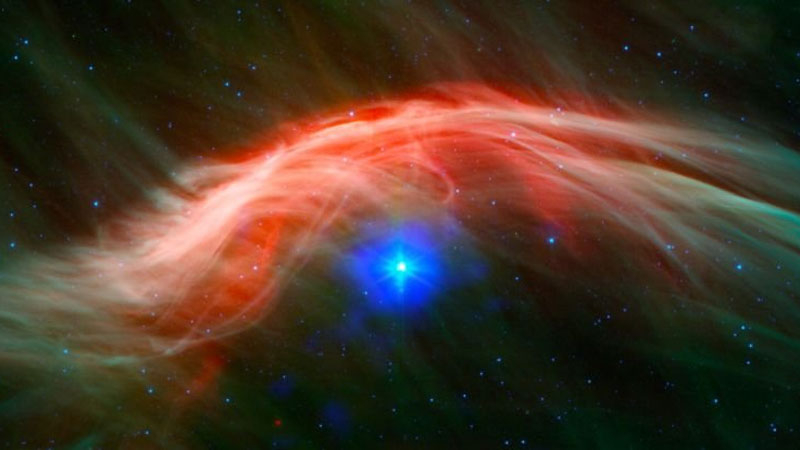Today, the Sun and we are in the so-called Local Bubble of the Universe, where there are few other stars. It is quiet and cozy, and little can happen that would threaten life on Earth. But it was not always so. Several million years ago, supernovae exploded near us, threatening life on the planet with ionized radiation that destroys DNA and leads to mutations.

Zeta Ophiuchi, a runaway star ejected by a supernova explosion in the Scorpius-Centaurus group. Image Credit: NASA
During their lifetime, the Sun and the Solar System have repeatedly flown through clouds of dust and gas left behind by supernova explosions. These traces are found in terrestrial sediments, for example, at the bottom of reservoirs. In particular, such a radioactive isotope as iron-60 can be found there. Its half-life is known, and this makes it possible to calculate the time when the Earth was exposed to radioactive influence from supernovae.
The evolution of biological life occurs without ionizing radiation. But radiation, as is known, leads to rapid mutations and repeatedly diversifies and accelerates changes in DNA and higher up the chain. There is no direct connection between supernova explosions and the evolution of biological life on Earth, although indirect evidence has recently been discovered.
Back in 2016, a paper was published in which a group of physicists described the discovery of two spikes in iron-60 levels in seafloor sediments. These spikes were dated with high precision: one was dated to about 6.5–8.7 million years ago, and the other to about 1.5–3.2 million years ago. A team of scientists from the University of California, Santa Cruz (UCSC) tried to calculate where supernova explosions could have occurred that could have left their mark on Earth at that time.
They rewinded the universe and determined that two supernovae could have been the culprits. In addition, an earlier burst of iron-60 on Earth occurred when our system crossed the boundaries of the Local Bubble. These notional boundaries contained isotopes that arose in earlier supernova explosions, the material from which was literally blown out of the center of the bubble to its then boundaries.
The more recent concentration of iron-60 on our planet could have been formed by one of two supernovae: either in the Scorpius-Centaurus cluster of young stars about 460 light years away, or in the Tucana-Chorus cluster about 230 light years away. The study shows that the first option is more likely. After the explosion, Earth could have been exposed to radiation for about 100,000 years. And during this time, the planet would have experienced accelerated mutations, which would certainly have affected the evolution of living organisms.
If the explosion occurred in the Scorpius-Centaurus group, the dose would be an additional 30 mSv per year for the first 10,000 years; for the Tucana-Clock group, the dose would be 100 mSv. However, the threshold for DNA damage may be around 5 mSv per year, which is about twice the natural background radiation on the planet. So 30 mSv per year certainly seems high enough for a supernova explosion to affect Earth’s biodiversity.
The discovery echoes another study. Scientists have found that Lake Tanganyika in the East African highlands saw a surge in fish-killing viruses between 2 million and 3 million years ago. That’s the same time period when Earth was last exposed to radiation from a supernova explosion. There’s no direct link between the two events, but the coincidence may not be coincidental.